Types of cacti: classification and popular varieties
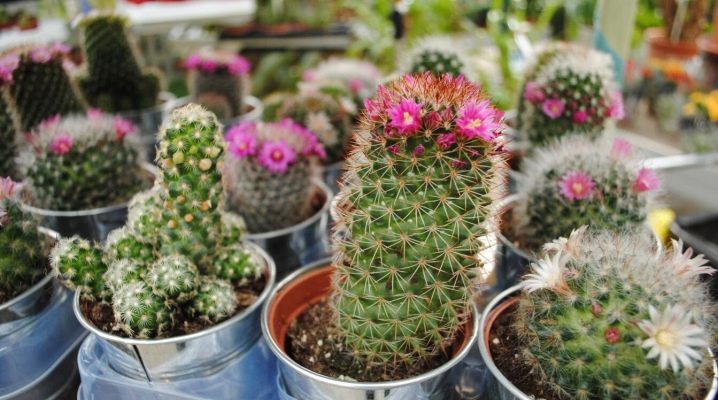
Bizarre, but at the same time strict geometry of forms, the most varied and colorful prickly outfits of stems with delicate, bright flowers suddenly bursting through them, extreme environmental conditions and amazing vitality - this is what makes the Cactaceae family so mysterious and attractive to study. For a long time, botanists have been enthusiastically exploring cacti, travelers, collectors and ordinary amateurs have shown no less interest in these amazing creatures of nature.
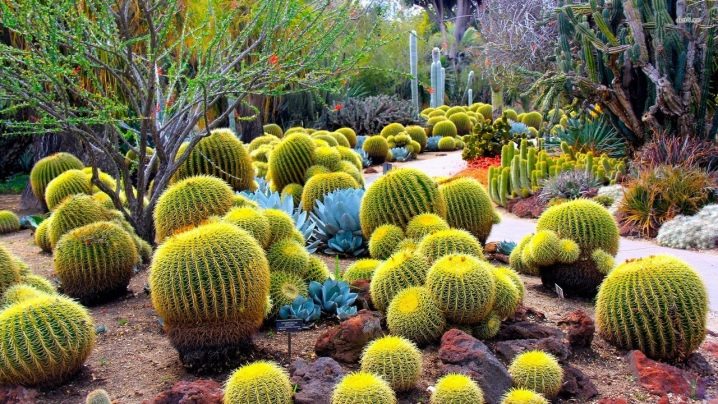
Cactus growing is an incredibly exciting and challenging branch of floriculture. Those who have just begun to be interested in mysterious thorns and their breeding often face difficulties in mastering the intricacies of agricultural technology and the study of multi-stage classification, not to mention the long, difficult to pronounce names of cacti and succulents. The purpose of this article is to acquaint the reader with the fascinating world of thorny plants, their species and biological characteristics, as well as orientate in the variety of popular varieties grown in closed conditions.
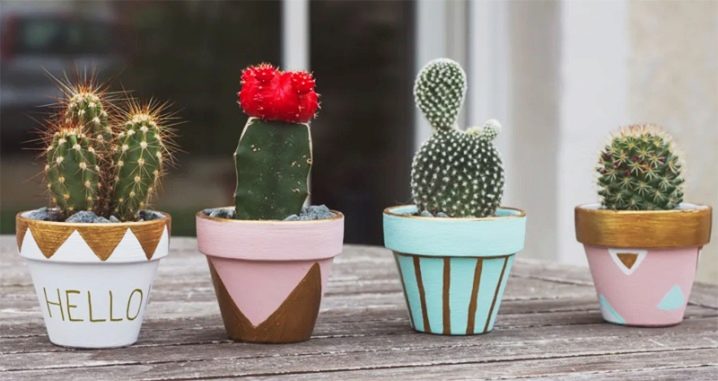
Family Description
The cactus family is represented by original perennial dicotyledonous plants.
The climate in the places where they grow is characterized by intense insolation, temperature jumps, and the absence of regular precipitation.
A combination of these factors led to the specialization of most of the Cactaceae family. In the course of a long evolutionary development and constant struggle for life according to the laws of living nature, cacti acquired a unique ability to survive in the most difficult and harsh natural and climatic conditions.
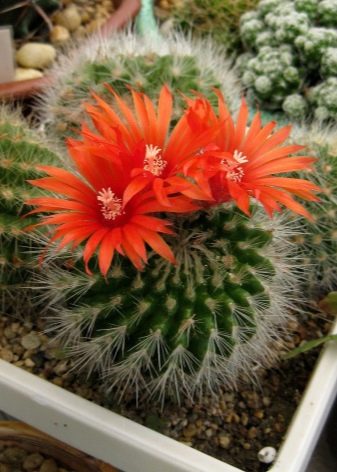
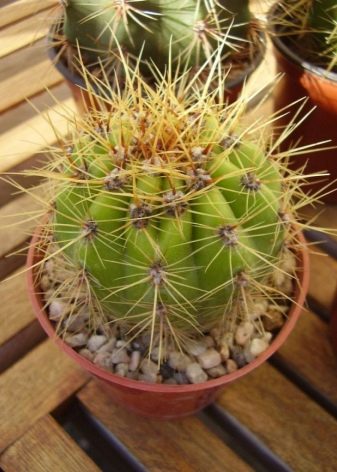
Area
The main natural area of distribution covers the territory of the American continent with adjacent islands. The richest species diversity of cacti can boast of Mexico, the "land of the Incas" of Peru, the Republic of Chile, bordering it in the northeast of Bolivia and in the east of Argentina. On their territory you can find all the existing varieties of thorny plants - from dwarf forms to real giants.
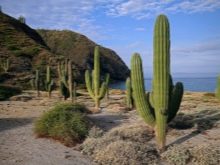
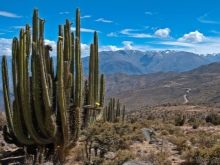
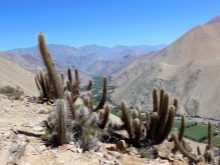
Artificial range of certain species of epiphytic cacti - Africa, Madagascar, South Asia (Sri Lanka), peninsulas in the Indian Ocean (Somalia, Indochina, Malacca, Arabia). Places where cactus grow are high mountain plateaus, grassy savannas, deserts, semi-deserts, evergreen rain forests, river banks, and flooded sea coasts.
Basically, they prefer loose gravel or sandy soils with a rich mineral composition and low concentrations of natural humic substances.
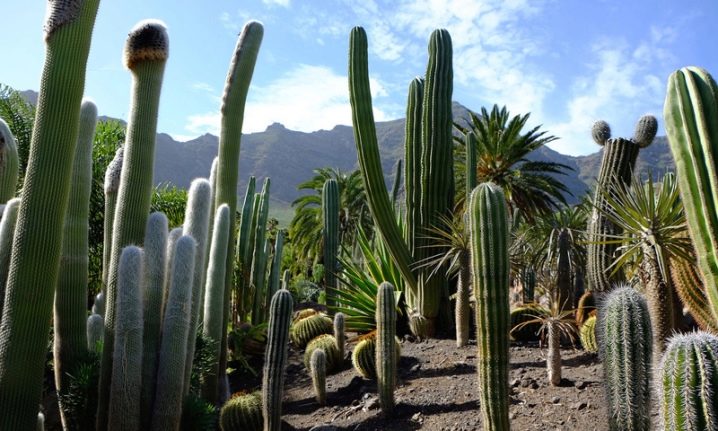
Features of biology
Stem
In the cactus family, 90% of plants have a thick massive stem with a dense hard skin and leaf variants modified under the influence of natural disasters (thorns, small scales). In shape, the stem can be flat, lozenge-shaped, leaf-shaped, spherical, straight and short cylindrical, fancifully curved serpentine. Stems are solitary, they can branch like bushes, grow like trees, or form dense and long clumps.

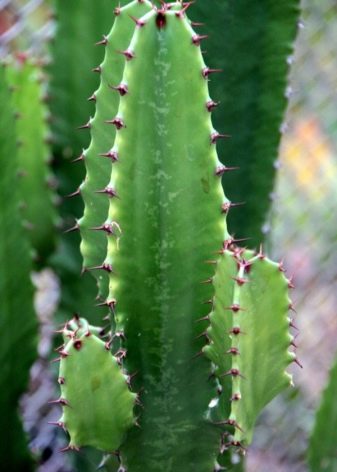
The color of the stem is predominantly green, in some varieties it is reddish or brown. In some species, its surface is covered with a waxy coating, which gives a peculiar bluish color. Epiphytic cacti, whose home is the equatorial forests, are characterized by a flattened leaf-shaped or thin rod-like stem shape. In addition to plants, the shoots of which reach a length of 20-25 m, there are many dwarf cacti with stems maximum 10 mm in length.
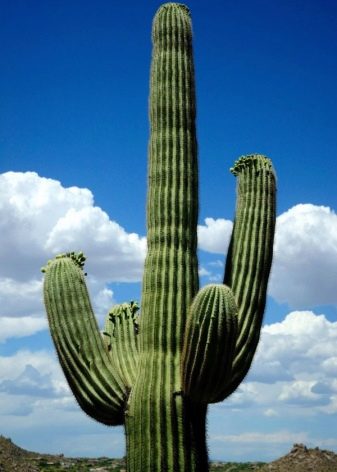
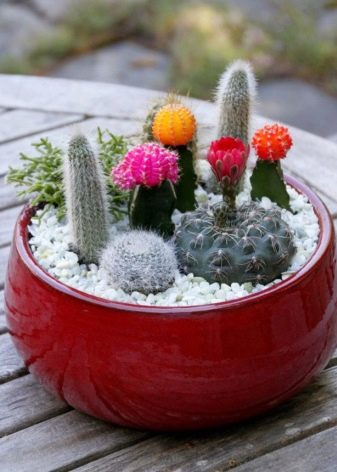
Survival mechanisms
The vegetative organs of these succulent stem plants with developed moisture-storing tissues are perfectly adapted to such a dangerous natural phenomenon of tropical latitudes, semi-deserts and steppes as drought.
Cacti use their fleshy body to store and store water and vital compounds in large quantities.
To extract moisture, they use the stem, the surface of which is covered with pores (stomata), the root system and thorns.
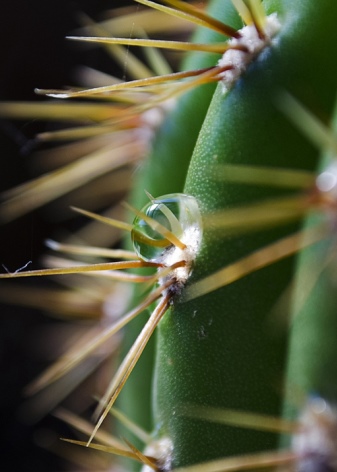
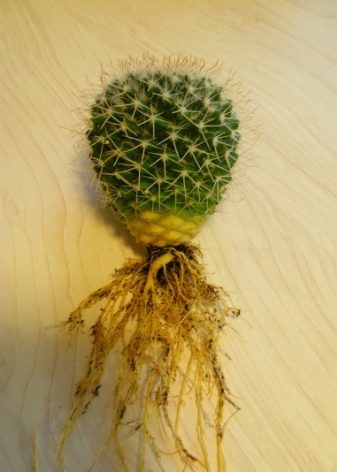
The needles act as miniature biological pumps that absorb water particles from precipitation. Cacti use up their stocks at a slow pace and in a strict economy, which keeps them alive in the dry season. In giant cacti with columnar stems reaching a height of 13-15 m and a girth of 1 m, water-storing tissues accumulate water by 1 ton or more.
Due to this, in case of drought, they are able to exist without interrupting the annual cycle in development for at least 10-12 months.
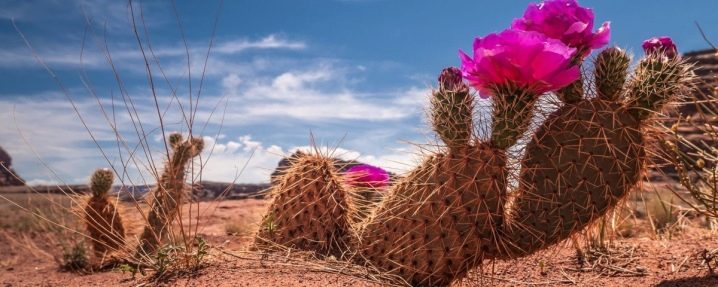
During their long existence under conditions of moisture deficiency, the course of photosynthesis in most cacti has changed. In the daytime, they actively accumulate the energy of sunlight, and at night they successfully start photochemical reactions. At night, the air temperature drops, which makes it possible to reduce the loss of water to a possible minimum.

Life in the driest regions of the planet forced the distant ancestors of cacti not only to use the stem as a store of precious moisture, but also to transform the leaves into thorns. The exceptions are species with true leaf blades: rhodocactus, peyreski, peireskiopsis.
The main function of thorns - "modified" leaves - to reduce moisture evaporation and protect the plant from herbivorous representatives of the animal world.
There are many cacti whose stems are not covered with needles, but with hairs that reduce evaporation, protect against temperature fluctuations and help store moisture. The shape and color of the thorns (central, lateral), which have a leafy nature, are very diverse.
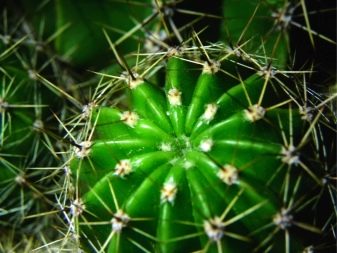

Features
The surface of the trunk can be ribbed with longitudinal or spiral ribs, symmetrical tubercles or conical papillae. At their top are the vegetative organs inherent in all members of the family - areoles (in Latin "platforms"), often pubescent or covered with thorns.
Areoles are the places where spines, hairs, lateral shoots and flower buds form.
Papillary cacti of the Mamillaria type, along with areoles, have axillae (translated from Latin "armpit") - another type of growth points located in the depressions near the papillae and tubercles. Axillas are the formation sites for lateral shoots and flower buds.
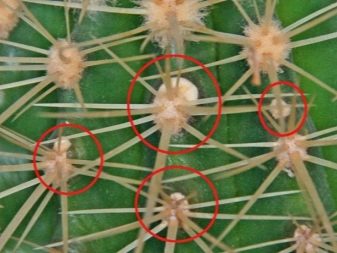
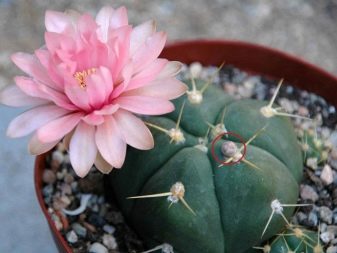
The center of the vegetative system, the growth point, is located in the apical part of the main shoot. In some varieties, there is a small depression in this place, and sometimes fluff, bristles or needles are present as protection of the fragile fresh growth from adverse external influences.
In case of damage to the growth point, the main stem throws out many lateral shoots.
Although many species themselves have side shoots, this is considered a natural phenomenon and a variant of the norm.
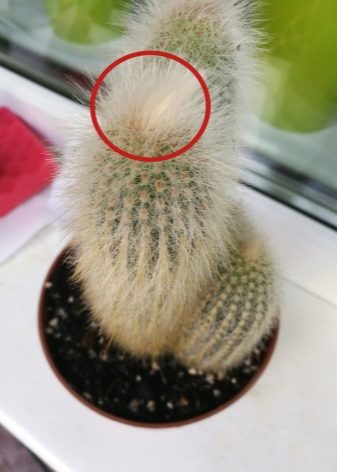
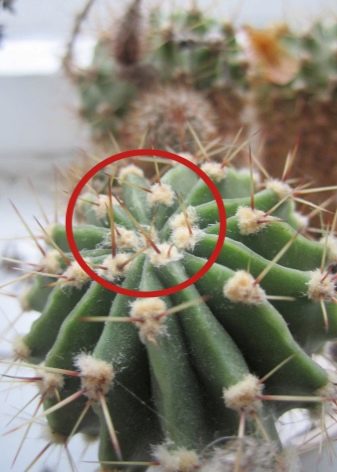
Root system
Large-stemmed cactus species, as a rule, are inhabitants of natural zones with an arid climate, have long tap roots. Natives of tropical rain forests are epiphytic plants with underdeveloped aerial roots.Varieties growing in moist, humus soil have small roots that grow in a dense bunch. Some species are characterized by a root system with thickened succulent roots of a tuberous or radish-shaped form, saturated with water and vital substances.

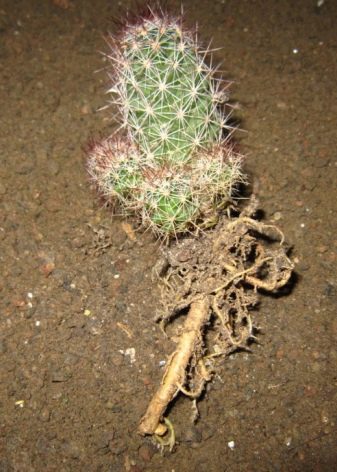
Flowers and fruits
Basically, the flowers of cactus are bisexual with one pistil and many stamens, most often actinomorphic (having at least two planes of symmetry) and often smell pleasant. In shape, they are bell-shaped, funnel-shaped, in the form of narrow tubes. Common flower colors are white, yellow, pale green, light brown, purple, lilac, red and all its gradations.
These plants do not have blue and blue flowers either in nature or in culture.
The fruits are berry-shaped and, in some cacti, are suitable for human consumption. In some species, they differ in juiciness and fleshy consistency, in others, on the contrary, they are dry. The seeds are predominantly small in size.
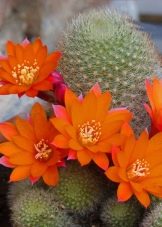
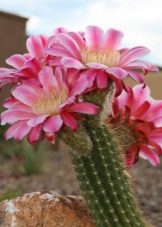
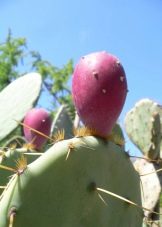
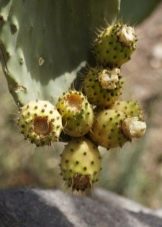
What are they?
In accordance with the botanical classifications, all representatives of the cactus family, which are more than 5000 names, are grouped into subfamilies according to a number of the most stable characteristics: the structure of ovaries, shape, color, location on the stem of flowers, features of reproductive organs and seeds. Total subfamilies 4.
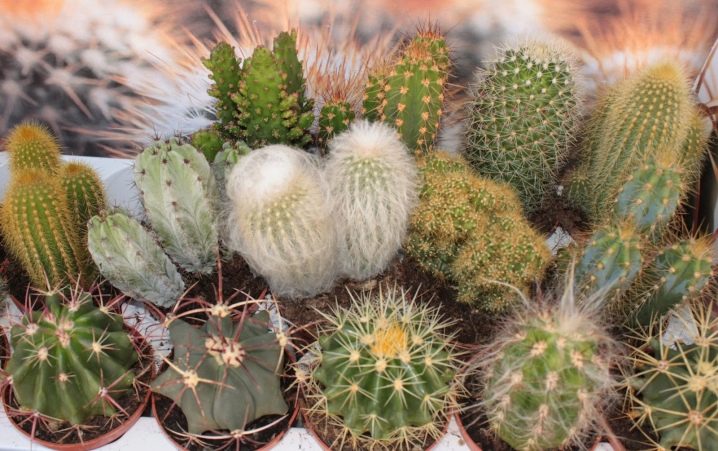
Peyreskiye
The oldest and most primitive subdivision of the Cactaceae family, which has a lot in common with deciduous plants. Consists of the only genus Pereskia, which plays the role of a kind of evolutionary link that connects cactus and leafy plants. Its representatives are characterized by full-fledged regular leaves and non-succulent stems. Flowers can be with a lower or upper ovary, single or collected in simple inflorescences (brushes).
Pereskians prefer humid equatorial forests, savannas and tropical deciduous woodlands of the Caatingi.
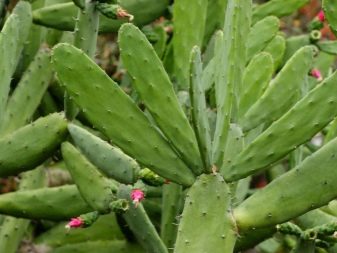

Opuntia
All plants of this subdivision are characterized by distinctly noticeable reduced leaves, which are necessarily present in young shoots, falling off in adulthood, succulent trunks with less or more pronounced segmentation, and the presence of unicellular outgrowths of glochidia. This is a special kind of spines in the form of needle-like miniature thorns, unusually sharp, hard and jagged along the entire length. Bunches of glochidia densely cover the areas of the stem near the areoles.
If they get into the mouth of animals, they strongly irritate the mucous membrane, thus protecting the plants from the unenviable fate of being eaten.
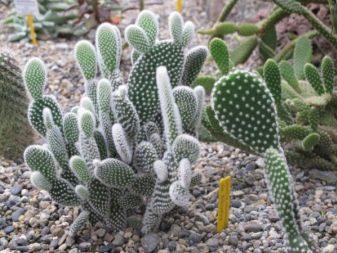

Mauhienia
These original cacti have long been classified as a subfamily of prickly pears. After recent studies have shown the phylogenetic remoteness of representatives of this subfamily from the rest of the cactus, they were combined into a separate subdivision, consisting of two species. Area - Patagonia.
This subfamily includes only one genus, whose representatives with small (maximum 1 cm) long-lived triangular green leaves and small cylindrical shoots are visually similar to prickly pears, except that they do not have glochidia. As they grow, they form large, compacted clumps.
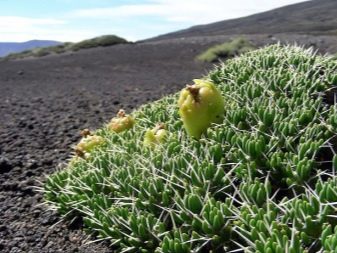
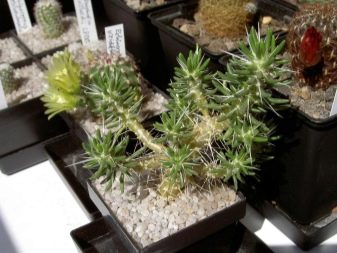
Mayuenias are hardy and slow growing. They grow without problems in the open air throughout the year.
Regardless of the growing conditions - indoors or outdoors, these plants require grafting on unpretentious strong prickly pears.
Flowering in cultivated Mukhinievs is an extremely rare phenomenon.
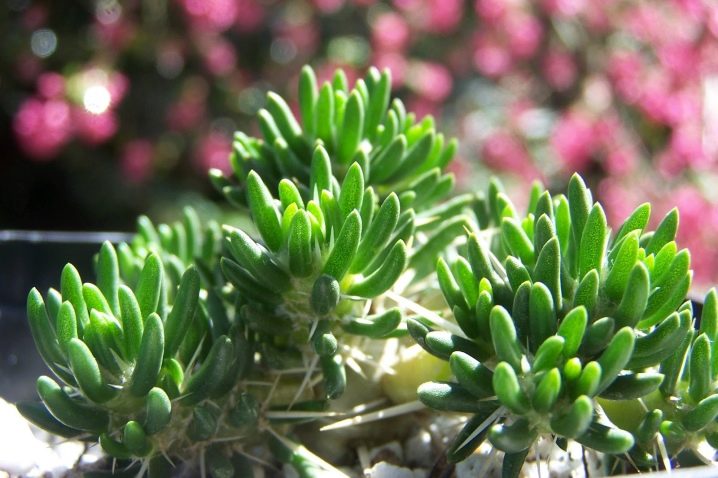
Cactus
A subdivision consisting of all the remaining genera of the Cactaceae family. The plants included in it are characterized by the absence of glochidia, and there are only rudimentary small leaves on the flower tubes. Sprouts in the form of a ball or cylinder have barely visible cotyledons in their infancy.The subfamily consists of epiphytic plants with whip-like or leaf-like stems and a huge number of xerophytes, impressive in a variety of forms (creeping, spherical, columnar, forming turf).
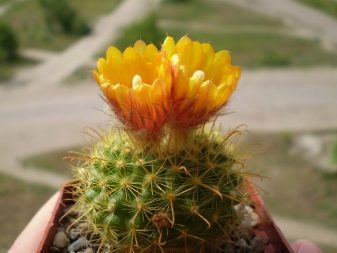

Those who grow cacti also use a simpler classification based on their appearance.
Shrubs
Hilocereus
The genus unites about 20 varieties, among which there are terrestrial, lithophytic, semi- and epiphytic forms. All of them belong to forest cacti that live in subequatorial forests.
Features and common features of representatives of the genus Hylocereus:
- stem color - all shades of green from light to intense tones;
- the presence of long thin creeping three- or four-ribbed shoots 3-12 m long, 20-70 mm in diameter;
- the ribs on the stems are wavy or sharp;
- flower shape - funnel-shaped, color - white, length and diameter - 10-30 cm;
- the number of spines in the areola is 2-10, some species do not have them;
- the length of the needles is from 0.1-1 cm, they are sharp needle-shaped or soft in the form of bristles;
- the root system is formed by aerial roots in large quantities.
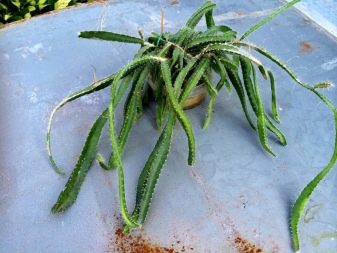
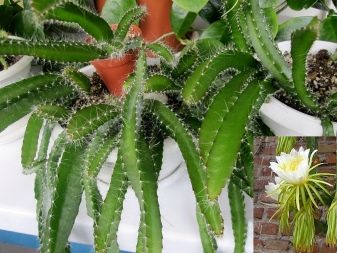
Some hylocereus species are epiphytic and only use host plants as a substrate to attach themselves. Particularly noteworthy is the multi-rooted species of creeping densely branched plants with rectangular stems of a rich green color, which becomes whitish in adult plants. Their fruits, known as pitahaya ("dragon heart"), have high nutritional and medicinal value, as they contain large reserves of vitamin C and lycopene with powerful antioxidant effects.
This pigment also helps in the fight against cancer, reduces the risk of developing cardiovascular diseases.
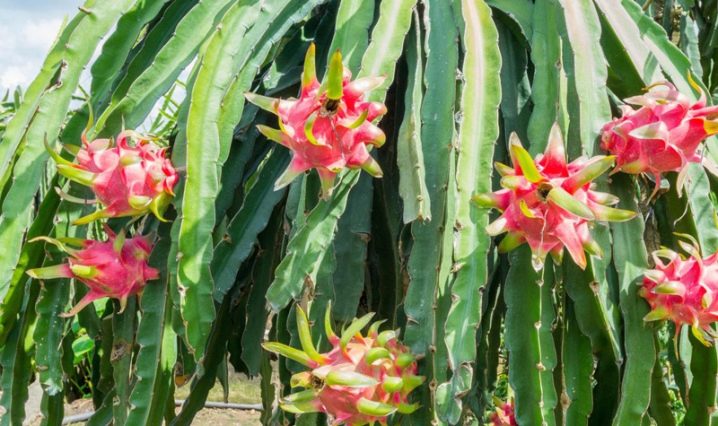
Tree-like
The tallest and largest representatives of the cactus family can be recognized by erect stems (one or more) with lateral shoots that resemble branches in appearance. In nature, many specimens reach a height of 25-30 m.

Cereus
The oldest genus of cactus, whose main feature is the presence of a long cylindrical stem. In large tree-like species, its height reaches 15-20 m. There are also many undersized shrub forms and epiphytes with a creeping stem and aerial roots. The species diversity includes about 50 items. Large species are distinguished by a powerful trunk, well-developed root system and crown, which is formed by numerous leafless lateral shoots.
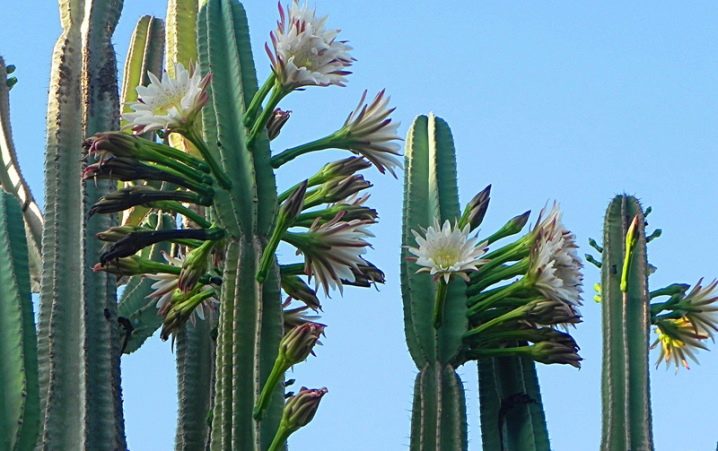
Stem with strongly pronounced ribbing and green-blue color, covered with black, brown or gray spines. The color of the flowers is white, pinkish, white-green.
During the day, when it is hot, Cereus keep them closed, opening only at night.
These plants are unpretentious in terms of keeping, grow quickly, are hardy as a rootstock and have a high decorative effect. They are widely used in phytodesign of apartments, offices, public places and to create cactus "alpine" slides.

Herbaceous
They grow in flat areas with heavy soils. These are plants with round, flat stems that can be pubescent or have weak spines. The color of the shoots is light or intensely green.
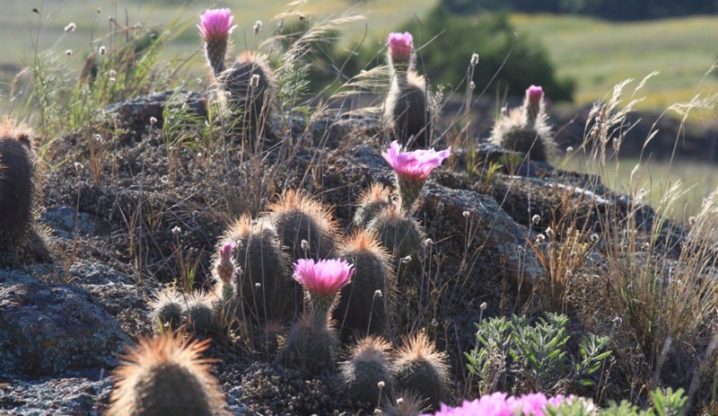
Mammillaria
One of the most evolutionarily advanced genera, which serves as clear evidence of the high adaptability of cactus to extreme climatic conditions. In nature, the colonies of these cacti occupy vast areas. In the natural environment, they can be found along the sea coasts, on the slopes and ledges of the chalk mountains at an altitude of 2.5 thousand meters above sea level. Mammillaria are miniature plants with spherical or cylindrical stems no more than 20 cm high.
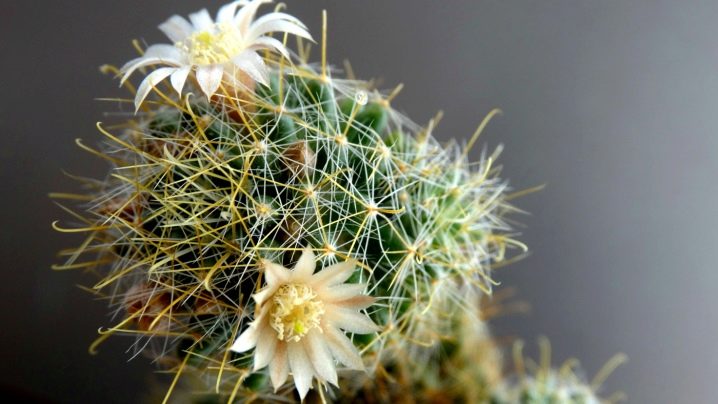
The peculiarity of this genus is the absence of ribbing in the stem.
Its surface is chaotically covered with numerous tubercles (papillae), from which needles grow in a bundle-like manner. Different varieties have a different arrangement of tubercles: in some forms, they encircle the axial part of the shoot, forming horizontal rings, in others, they are arranged in a spiral manner. The lower papillae are pubescent, and needle-shaped spines grow from the apical ones. The sites of flower bud formation are more pubescent.
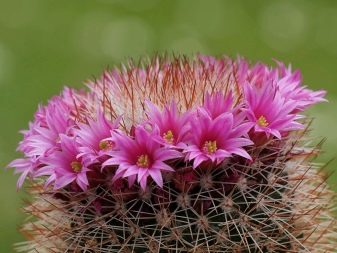
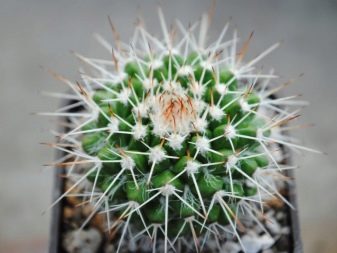
Liana
In ampelous (curly forms) shoots, due to their flexibility, softness and length, resemble vines. Among the representatives of this group, there are many plants leading an epiphytic lifestyle in symbiosis with nearby vegetation.

Selenicereus
These cacti are native to the equatorial rainforest. Among them, there are terrestrial, epiphytic, and lithophytic forms. Plants cling to nearby supports and are held on to them with the help of aerial roots, densely growing on thin lashes-shoots. The length of shoots in the largest specimens can reach 10-12 m, while their thickness is only 2.5-3 cm. In different parts of the planet, these plants are called "dragon" or "snake" cactus, "blooming in the night", each of of these names somehow reflects the characteristics of these liana-like cacti.

The presence of long shoots in combination with a grayish-green color gives the plants a snake-like appearance. Some species are characterized by a zigzag shape of the stems, reminiscent of a fern leaf, although it can be compared with the tail of such a fantastic creature as a dragon. Selenicerians tend to bloom at night if environmental conditions are favorable., then at the same time they are able to produce up to fifty flowers, moreover, very large, with a diameter of 25-30 cm.
It is possible to admire the beauty of the blooming Selenicerius only for a few night hours, since with the arrival of the morning the petals wither and fall off.
Flowers of representatives of this species are considered the largest in the cactus family. But in culture, these plants are extremely reluctant to bloom, even if agricultural technology is followed impeccably.
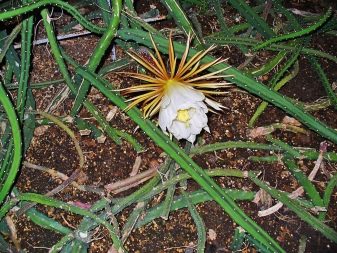
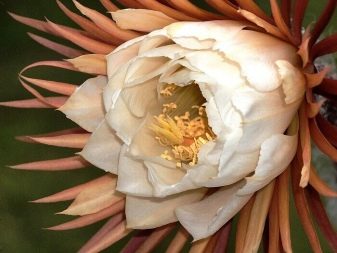
Wild varieties
Another criterion by which cacti are classified is the place of growth, and this is done purely for practical purposes for the convenience of navigating in the diversity of species. Depending on the place of residence, cacti are forest (tropical) or desert.
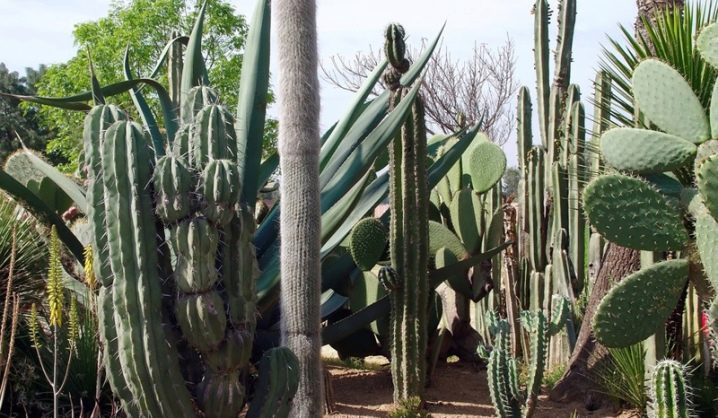
Forest
About 500 thousand years ago, after a powerful earthquake, the direction of the ocean currents changed towards the South American continent, which put an end to dry weather in this part of the planet and marked the beginning of a new climatic era - the era of monsoon rains. The inhabitants of desert and semi-desert formations - cacti and succulents - had to adapt to the new reality. Their spherical trunk has completely lost its thorns and transformed into a chain of elongated-flattened segments-segments.
The plants themselves no longer needed to save water; moreover, they had to protect themselves from flooding.
To this end, cactus plants have joined the epiphytic lifestyle, moving to the trunks of large trees and shrubs.
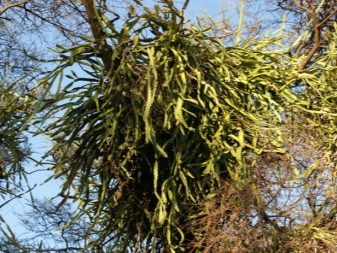
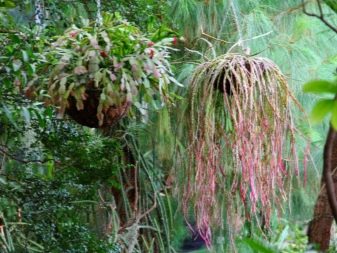
Although forest cacti are not as numerous as their desert cousins, they are no less decorative and are also of considerable scientific interest. Let's take a look at some of them.
Ripsalis
Under natural conditions, epiphytic forms of Ripsalis choose tall trees for life, and lithophytic ones - rocky protrusions. The genus Ripsalis includes the most ancient forest cacti, which have an unusually spectacular appearance. These exotics can look completely different. Generally, these are densely branched succulents with shoots of various shapes: stellate, flat, with a round cross-section.
For some forms, the complete absence of thorns is characteristic, while in others, on the contrary, modified leaves can be observed in the form of inconspicuous hairs.
The thickness of the stems can be different: there are forms with juicy fleshy shoots and, conversely, with thin ones. Flowers in different species are yellow, white, red.
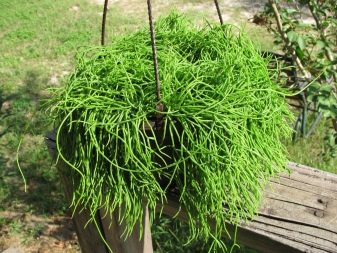

Epiphyllum
In large-flowered epiphytic cacti, growing in the form of spreading shrubs, the root zone of which becomes woody with age. The shape of the stems is leafy, which is why these plants are often confused with leafy cacti (their scientific name is phyllocactus). The color of fleshy shoots with wavy serrated edges is rich green, their surface is covered with small spines and leaves in the form of small scales. Epiphyllums have very beautiful flowering. Large fragrant flowers are placed on long flower tubes. Their color can be very different - from delicate white, pink and cream to rich red and yellow.
Because of the fantastically beautiful flowers, these exotic plants are called "orchid cacti".
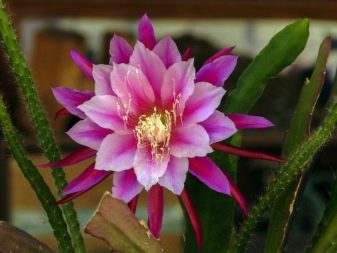
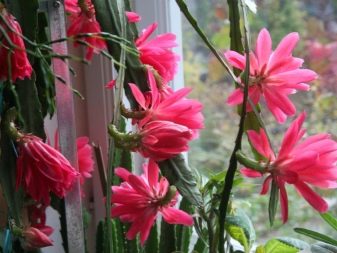
Desert
These are the most unpretentious and hardy representatives of the cactus family. They live in natural areas with extremely harsh conditions: low precipitation, extreme daily temperature changes, heat combined with strong gusts of wind, and the soil is poor in humus. We offer you to get acquainted with the most colorful desert specimens.

Saguaro (giant Carnegia)
This is the tallest and largest representative of the cactus family, whose height can reach 24 m (9-storey building), girth - 3 m, and weight - 6 tons, and 80% of the stem of the world-famous giant succulent consists of water. Habitat - North America, Sonora Desert Formation.
The maximum lifespan of this plant is 150 years.
Surprisingly, during the first three decades, the giant Carnegia reaches a maximum height of one meter. Further, it grows at an average speed for a cactus, adding every millimeter every day and taking on the most bizarre forms due to its processes. The formation of its appearance is completed only by the age of 70, when the plant finally turns into a huge trunk with bunches of lateral shoots.

The color of the flowers is mainly white, although sometimes you can find saguaro with red, yellow, light green, orange flowers. You can see blooming carnegia in all its glory, that is, with open flowers, only at night, since during the day in the heat the plant keeps them closed. Bees show a keen interest in saguaro flowers. Cactus honey is attributed to its special taste and the ability to cause euphoria.
The taste of the edible fruit, according to eyewitnesses, is similar to pitaya ("dragon heart") combined with rice.

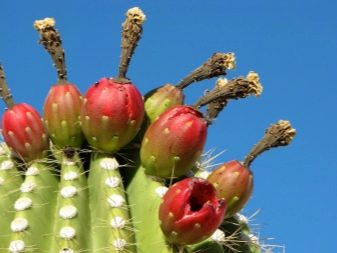
Trichocereus
The genus contains about 75 varieties of large tree-like candle-shaped cacti. In the first years of life, the shape of the ribbed stems is more rounded, and with age it changes to cylindrical or clavate. The color of the stems with rounded deep ribs in the amount of 5-35 pieces is mainly green, sometimes it gives off a blue or silver tint. In nature, these stem succulents are capable of reaching a length of 10-12 m, in culture - a maximum of 0.5 m.
Most trichocereus are characterized by the presence of developed V-shaped spines of a yellowish-brown color and up to 20 mm long; in some species, needles are absent. When flowering, the top of the axial part of the shoot is covered with fragrant flowers of white, pink, red, cream color. The diameter of the flowers is 20 cm, the flower tube is long, their plant opens only at night.
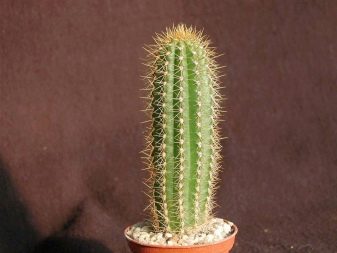

In this genus, there are several venomous species containing hallucinogenic substances that cause vivid visual illusions.
However, this effect is the most "harmless" one. The skin at the point of contact with the plant grows numb, there is a temporary loss of sensitivity. Such cacti have a suppressive effect on the central nervous system, and due to prolonged interaction with them, complete or partial muscle dysfunction (paralysis) occurs.
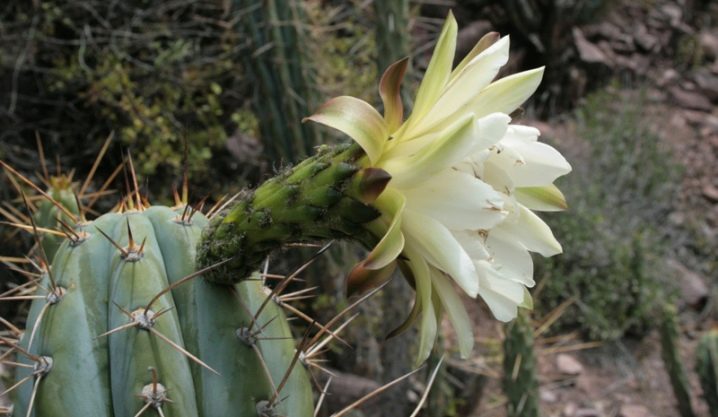
Domestic species and varieties
Not all types of cacti and succulents are suitable for keeping in an apartment, since many of them have impressive dimensions and they simply do not have enough living space in such conditions. Ideal plants for indoor cultivation are prickly pears, astrophytums, epiphytic species - Ripsalidopsis or "Easter" cacti and Schlumberger ("Decembrists"), their ampel and standard forms are especially decorative.
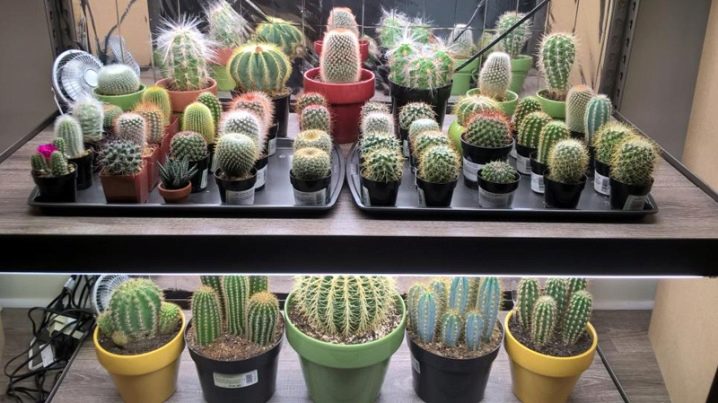
In modern phytodesign, various types of cactus and their hybrids are used with might and main. They are indispensable when creating florariums - closed ecosystems in glass vessels, especially on the theme of the tropics or deserts. In order for compact mini-landscapes to be harmonious in shape, height and color of plants, it is necessary to be well versed in the varietal diversity of cacti and know their biological characteristics.
It is also useful to study this information for those who are just planning to start growing and collecting them.

Ferocactus
Representatives of the genus Ferocactus are distinguished by the columnar or spherical shape of the stem. In the largest specimens, the height of the stems can reach 3 m, and in cross-section - 0.5 m.The shape of the central spines is hook-shaped, and they themselves are flat and can reach a length of 15 cm.The color of the flowers is red, yellow, orange, the shape is bell-shaped, length and diameter - 2-6 cm. There are many popular species, Latispinus is especially interesting.
This is a highly decorative species with a compressed-spherical or flat stem and a surprisingly beautiful prickly outfit of the widest, highly flattened needles: none of the cactus known to science has so flat. All spines grow upward, with the exception of one bottom, intense red or bright yellow, with a hooked tip curved downward.
Because of this feature, the cacti of this species were nicknamed "devil's tongue".


Notocactus
These small ball-shaped or cylinder-shaped cacti have characteristic expressive purple stigmas. The appearance of lateral shoots in notocactus is extremely rare. Wild plants can grow up to a maximum of 1 m. In young plants, the thorns are tender, with age they become coarser, and the initially gray color changes to bronze. Many varieties of notocactus are successfully growing in the culture, many of them are recommended for growing for beginners due to their unpretentiousness in terms of requirements for conditions of maintenance and care.

Hatiora ("Easter cactus")
It is a vivid representative of the flora of the tropics, a succulent, a native of moist evergreen Brazilian forests, leading an epiphytic or lithophytic lifestyle. Hatiora, aka Ripsalidopsis, is a completely leafless plant with segmented, highly branched stems, small fragments of which can have a flat or cylindrical shape. Shoots are drooping and erect, lignify with age, transforming into a trunk.
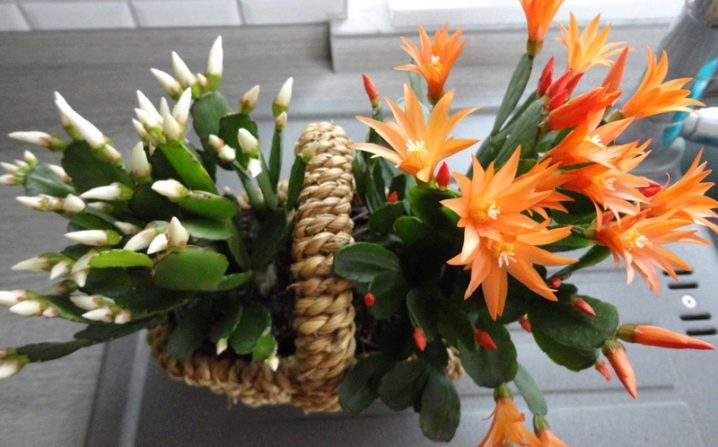
Flowering occurs at the end of the tropical summer, when winter ends in the northern hemisphere. In some species, flowers are formed in the upper part of the stems, in others, along the entire length of the stem. Most often there are plants with red, pink flowers, less often - yellow in color.
In culture, the special whims of this exotic include the need for diffused light, moderate watering, high air humidity and the organization of a dormant period.
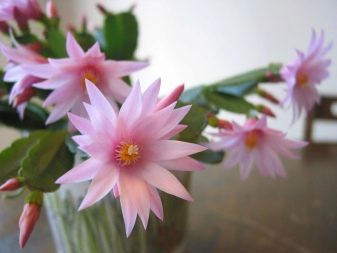

Lobivia
This is one of the most suitable classic Echinonopsis cactus species for beginner hobbyists. Lobivia are quite compact and bloom seamlessly. These plants look different. Some forms are characterized by the presence of an egg-shaped stem with rounded ribs and yellow needles; in large-flowered varieties, the axial part of the spherical shoot with a pronounced ribbing is characteristic. The traditional flower colors are red and yellow.
Lobivia are "fertile" and in one season manage to acquire numerous children, which is why there is no free space in the pot.
Their wild relatives behave in a similar way, forming densely populated colonies in their natural habitat.
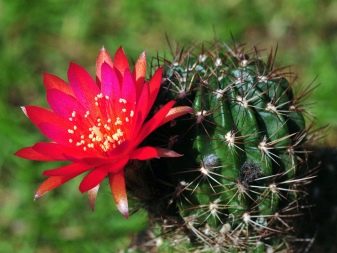
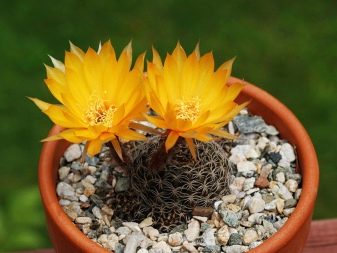
Prickly pear
Basically, prickly pears grow in the form of shrubs with erect or creeping shoots; tree-like forms are less common. All plants of this genus are characterized by the presence of succulent jointed branches, glochidia (microscopic bristles) that are invisible to the naked eye, and single flowers. The color of the flowers is yellow, orange, red. The popular name of these cactus is "hare ears", which they were given because of the peculiar shape of the stems. In prickly pears there is a strong difference in size: among the representatives of this genus you can find creeping on the ground "babies" the size of a mouse, and large plants as tall as an elephant.
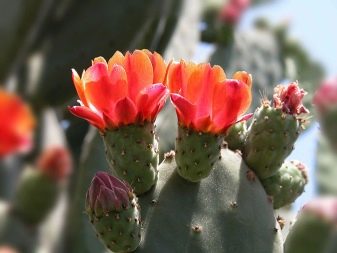
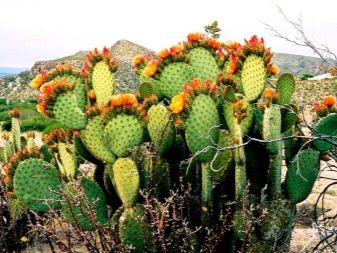
Rebutia
These perennial small succulents have long won the hearts of our cactusists thanks to their beautiful, sometimes repeated flowering. Plants are distinguished by a fleshy spherical stem with a slightly depressed crown, moderate ribbing with a spiral arrangement of ribs, divided into tubercles. Areoles often located on them produce many small bristle spines. The maximum diameter of adult plants is only 10 cm, in the smallest forms it does not exceed 5 cm. However, for such a modest size, the flowers of these cacti are quite large, and such a contrasting combination looks very impressive.
The colors are impressive with a variety of shades from reds, creams and pinks to expressive carrots and yellows. In terms of care, rebutia do not require anything beyond what is necessary for the full development and growth of most cactus plants.
But unlike many of their brethren, who avoid direct sunlight, they tolerate them surprisingly calmly.
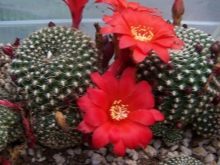
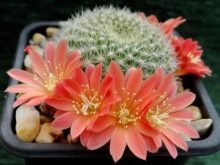
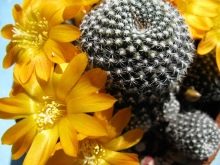
Mammillaria
The article has already mentioned the amazing representatives of this diverse genus. Such charming crumbs leave few people indifferent, because they have incredibly beautiful flowering. At the top of the cylindrical shape, a spectacular "diadem" of several miniature flowers is formed. Spherical specimens are often completely covered with flowers with narrow petals. In shape, the flowers are tubular, bell-shaped, disc-shaped with a wide-open corolla, in size - medium, in color - white, pink, red, silver, lemon.
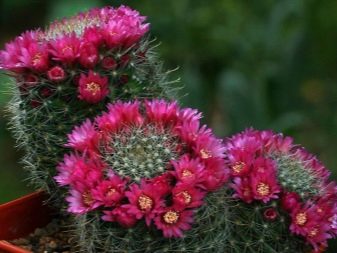
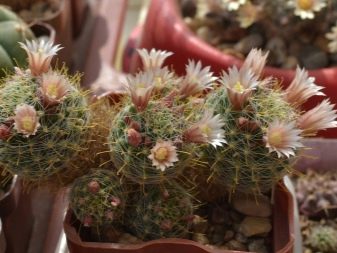
Ariocarpus
Due to the presence of a succulent rhizome, which looks like a turnip or pear, Ariocarpus easily tolerate long periods of drought. The stems of these succulents are pressed to the surface of the earth. The appearance of the fleshy wrinkled shoots in the form of triangles, painted in a rich green, brownish or gray color, is also interesting. Due to the circular tiered arrangement of the shoots, the bush is compact both in height and in diameter, which is a maximum of 12 cm. The stems are covered with rudimentary spines, in some species the shoots are omitted.
The leaves contain a thick slime that has long been used as a glue.
During flowering, ariocarpuses, which in ordinary life look rather inconspicuous, completely transform, dissolving bell-shaped flowers with elongated, narrow glossy petals. The color of flowers can be whitish, various shades of pink, lilac.
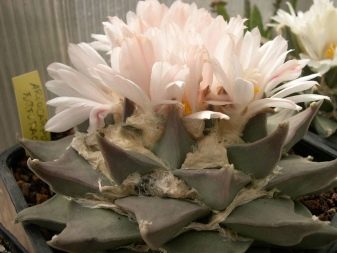
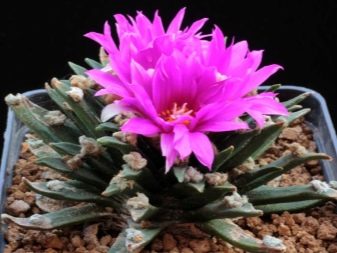
Cleistocactus
This genus can be recognized by its columnar stems, erect or creeping along the surface of the earth, attractive spines and unusual flower shapes. In wild species, shoots can reach 3 meters in height. The ribbing of the stem is weak. From numerous areoles, bunches of bristly spines grow, almost completely hiding the shoots.The fact that the thorns have a grayish, golden, brownish, white color makes the appearance of Cleistocactus even more expressive.
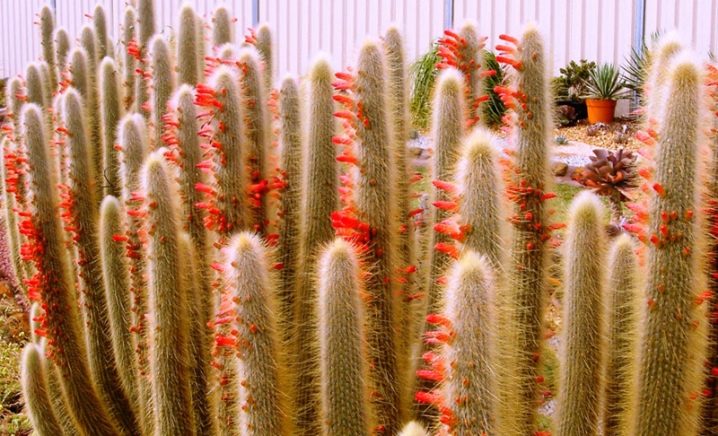
This genus is unique in that the buds of an elongated tubular shape and covered with a layer of scales remain almost closed, and this gives them a resemblance to cones.
Despite this, self-pollination mechanisms are triggered inside them. This phenomenon has a name - cleistogamy, which sheds light on where this genus name came from. The flowers are colored in intense red, like that of Strauss's cleistocactus, coral or yellow tones. In culture, the well-being of cleistocactus depends on abundant watering and systematic feeding throughout the year. Plus, it is important that the place where the pot stands is bright, but with limited access to the sun at noon.
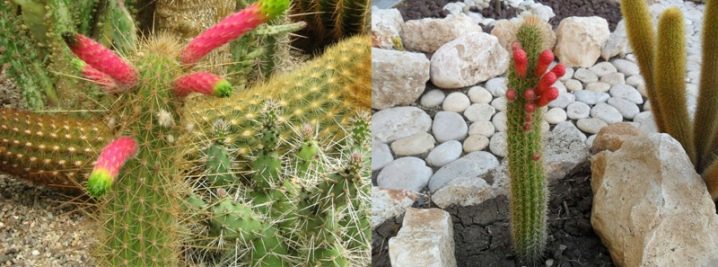
Gymnocalycium
These spherical, almost round plants have an incredibly dense thorny outfit of large, sharp, straight and curved thorns, which in nature reliably protects them from being eaten by animals. The central spine is present in a single copy, in some species it is not at all. The stem is green with a grayish or brownish tinge, it can be single or with numerous offspring at the base. In different species, its diameter is 2.5-30 cm.
Through the efforts of breeders, many chlorophyll-free forms with yellow, purple, red stems have appeared. Flowering occurs 3 years after planting. The color of flowers can be snow-white, in delicate pastel shades or bright saturated colors. The flowering period lasts a maximum of a week, then they crumble.
Gymnocalycium is quite simple to maintain, the only thing they make more demanding is the light mode. They need bright lighting, especially in winter.


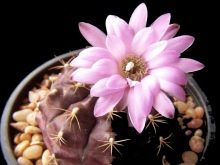
Astrophytums
The shape of unusual cactus-stars can be cylindrical or spherical. The stem of these unique stellate succulents has a pronounced ribbing, the number of ribs is at least 5 pieces.
The surface of the body is usually covered with light felt dots (short hairs), whose function is to absorb atmospheric moisture.
The woolly coating also provides protection from the scorching sun rays, effectively reflecting them and protecting the stem from burns. Some species have a spiky outfit of long needles on their ribs. All other species are characterized by the absence of thorns, which, in combination with the grayish skin, makes them look like scattered stones. The color of the flowers is various shades of yellow.
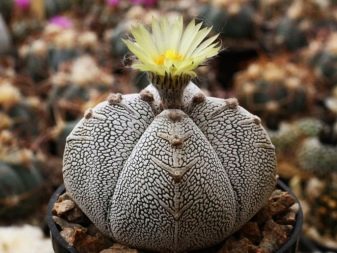

Echinopsis
In nature, these cacti up to 1.6 m in height tend to form colonies that occupy vast spaces. Most Echinopsis are slow-growing perennials with a spherical or cylindrical shiny stem. The color of the stem with pronounced straight ribs can vary from greenish to deep green. On the ribs there are large areoles with short hairs. The number of radial subulate spines is 3-20 pieces, the central ones are 8 pieces, in some species they are completely absent.
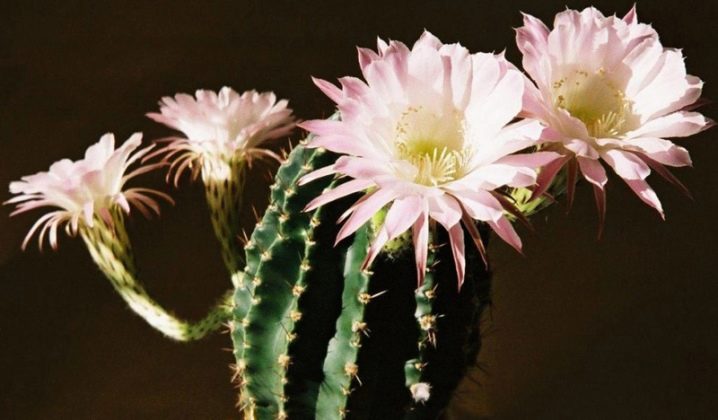
Both types of needles are rigid, awl-shaped, straight or curved, grayish-brown in color, up to 7 cm long. The shape of the flowers is funnel-shaped, the color is white, pink with a delicate lilac shade, yellow, reddish. The flowers are located laterally, attaching to the stem through long scaly processes. Most species tend to bloom in the evenings.
These cute "hedgehogs" are the favorites of many flower growers who speak of Echinopsis as unpretentious in care, viable plants with regular flowering.
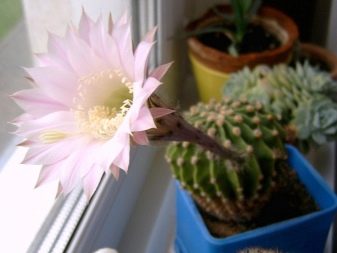
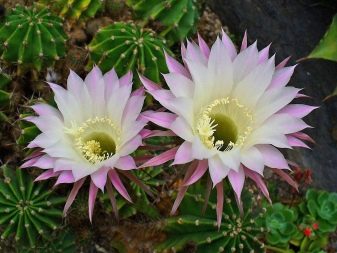
Rare and unusual specimens
Cacti are one of the most extraordinary representatives of the plant kingdom, but even among them there are sometimes such specimens whose external data and features of biology, even by cactus standards, seem at least strange.They can be poisonous and dangerous or capricious in content to such an extent that only a few dare to deal with them.
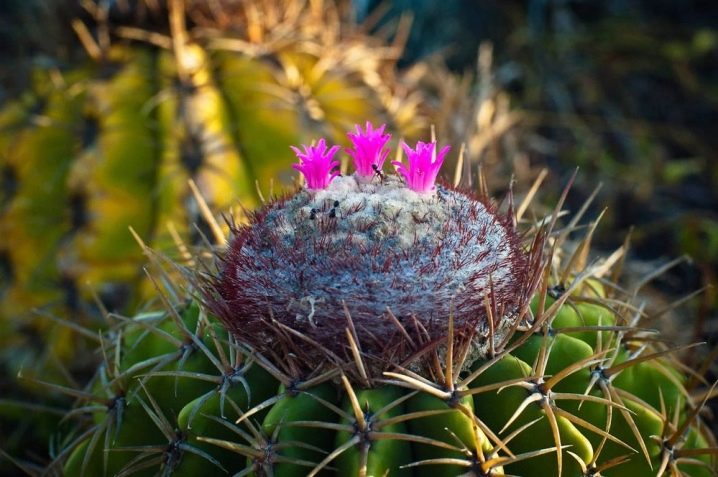
Yaviya crested
Cacti of this rare and poorly studied species have a very unusual shape: the growth of a spherical stem with a diameter of only 2.5 cm starts from a conical rhizome, turning into a wavy comb and expanding upward. There is still no consensus among biologists about the structure of the phenomenon. Some consider the change in shape to be the result of sudden changes in temperature, while others - the result of a genetic mutation. The Javies are used to surviving daily in the very harsh conditions of their homeland - these are the mountains and deserts of the Argentine province of Jujuy with an arid climate.

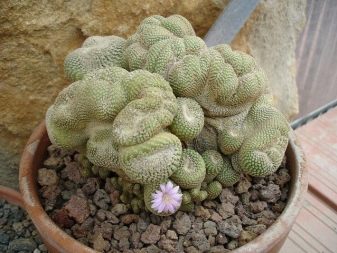
For life, they choose rocky crevices, horizontal and gentle mountain slopes. These mini-cacti wait out the dry season almost underground, protecting themselves from the scorching sun, and after the rains they swell from moisture and come to the surface.
They manage to save life only due to the root swollen in the rainy season.
The stems of the appearances have a flat top, covered with hairs. The shape of the lateral wrinkled stems is cylindrical. Javi can bloom, and very beautifully. Their flowers are pink, 2 cm in diameter.
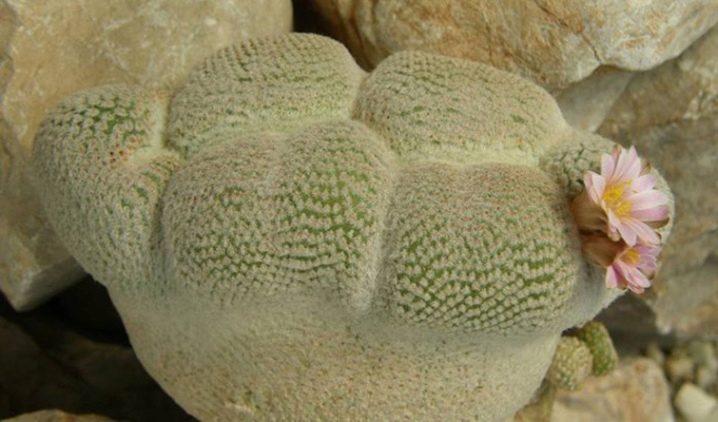
Lofofora Williams (peyote)
A succulent plant with an appearance that is absolutely atypical for cacti. It is a plant with a spherical, laterally flattened segmented stem, reaching a maximum diameter of 15 cm. The stem is green with a bluish tinge and a velvety skin to the touch. During the flowering period, its crown is decorated with a single flower of reddish, white, yellow color.
This cactus is known all over the world for its unusual properties. Its juice is rich in alkaloids, which have a tonic and healing effect.
But in high concentrations, it has a powerful psychedelic effect, in connection with which many countries have banned the cultivation of this crop.
Animals, after eating peyote, lose their appetite and fall into a trance. Official permission to use lophophora was received by Indian tribes, who have been using it in their rituals for a long time.
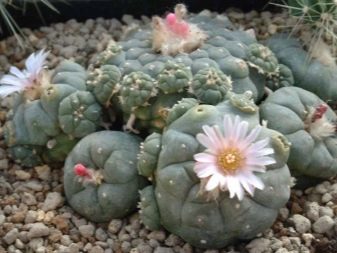
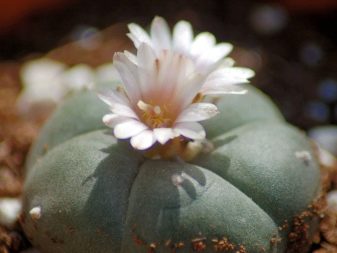
Encephalocarpus strobiliformis
This is a representative of a monotypic genus, a native of Tamaulipas (state in Mexico). Prefers rocky slopes, where it practically merges with the landscape due to its non-standard appearance. Its rounded, sometimes ovoid gray-green body with a densely pubescent apex covers many spiral-shaped keeled papillae, resembling the shape of scales on the cones of coniferous trees. The height of the stem reaches a maximum of 8 cm, the diameter is 6 cm.If at normal times encepharocarpus are perfectly camouflaged between stones, then during flowering, when the upper part of the stem is covered with red-violet flowers with a contrasting yellow anther, it is difficult to miss them.
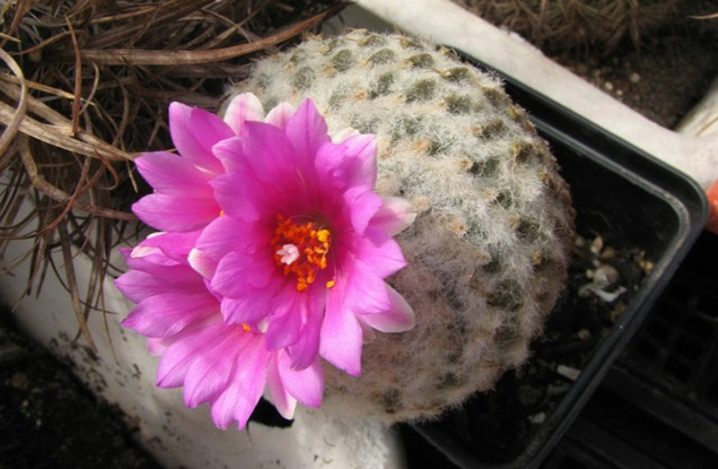
Hilocereus sinuous ("Queen of the Night")
A type of liana-like epiphytic cacti with climbing three-lobed stems. World fame has brought him a very beautiful night flowering and edible fruits called "dragon fruit" or pitahaya. These plants bloom only once a year, forming large fragrant flowers of snow-white color. At a time, cacti can form one flower or several.
Due to the powerful sugary aroma of vanilla, being near the blooming "queen of the night" can cause severe discomfort.

Winter's Cleistocactus
The most popular type of creeping cactus with the difficult to pronounce name of hildevintera kolademononis. The natives of South America call these flowers "monkey's tail", and this name suits them very well.
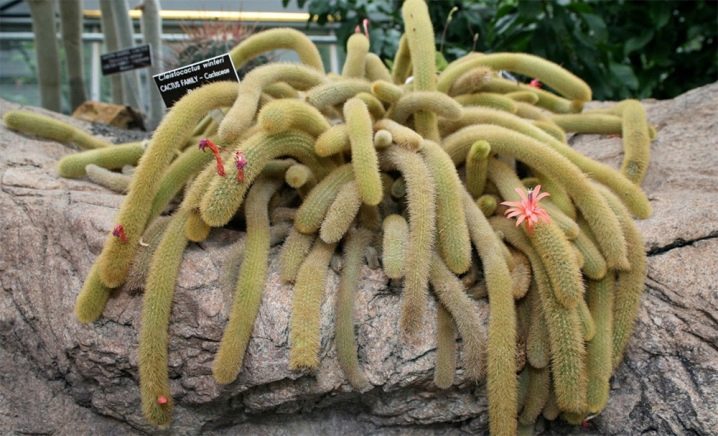
Distinctive features of these unusual cleistocactuses:
- the presence of green hanging thin stems with dense yellowish-golden pubescence, their length does not exceed a meter, and the diameter is 2-2.5 cm;
- the large size of the flowers of a rich carrot or expressive pink hue, beautifully contrasting with golden pubescence;
- when flowering, the tubular buds with a scaly coating remain closed, causing associations with long, thin, bright buds.
Winter's Cleistocactus is not only highly decorative, but also useful plants. Indoors, they serve as natural air filters, removing harmful compounds from the air.
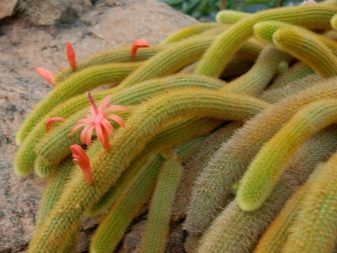
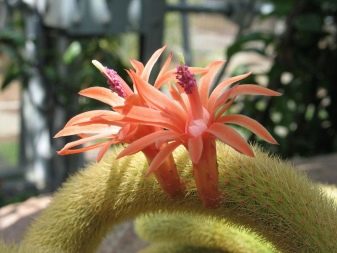
Navajoa
A rare endangered species of cacti, as beautiful as they are capricious in terms of conditions of maintenance and care. In nature, they choose lime-sandy rocky high-mountain slopes for life. These natives of Arizona and Holbrooke are named after the North American Navajo Indians. Navajoa are miniature plants with a greenish-blue spherical stem, which is 2/3 buried in the soil. They have highly curled, flexible spines with microscopic fine hairs at the ends. The color of the flowers is yellow or white.

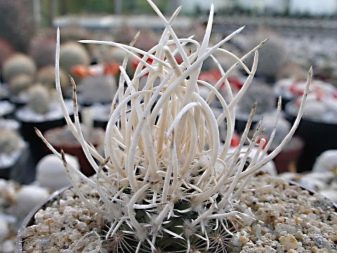
The cultivation of these cacti requires a masterly skill, as they come from areas scorched by the sun, where rain can wait for months. Such plants are simply not able to get used to the humidity in greenhouses or greenhouse pavilions. An excess of moisture, no matter whether in the ground or in the air, has the most negative effect on their appearance, provoking abnormal growth in height and a loss of beauty of the thorns, which are greatly shortened.
Therefore, flower growers have to scrupulously observe the watering regime and plant them on suitable rootstocks.

Blossfeldia tiny
The smallest cactus known to science, representatives of the monotypic genus Blossfeldia. They choose small rocky crevices for life, where they cling with their roots to narrow sections of soil with amazing tenacity. These are plants with small pea-stems, the top of which is slightly flattened. They are characterized by very slow growth, the formation of lateral shoots occurs only with age, when the root system is sufficiently developed. Through the cracking skin on the stem, babies appear, as their number increases, the plants become like stony heaps.
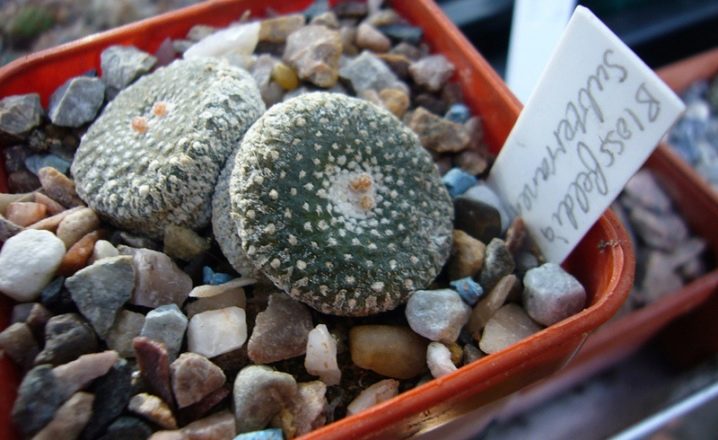
The Blossfeldia has a reputation as a "deceiving cactus", as it lacks all the hallmarks of a cactus, be it ribs, tubercles or thorns.
Only the lightest pubescence of the areoles with a spiral arrangement on the stem betrays its belonging to the family of thorny plants. The flowering period occurs in early spring, at which time the Blossfeldia with wide-open white or pale pink flowers looks simply charming.
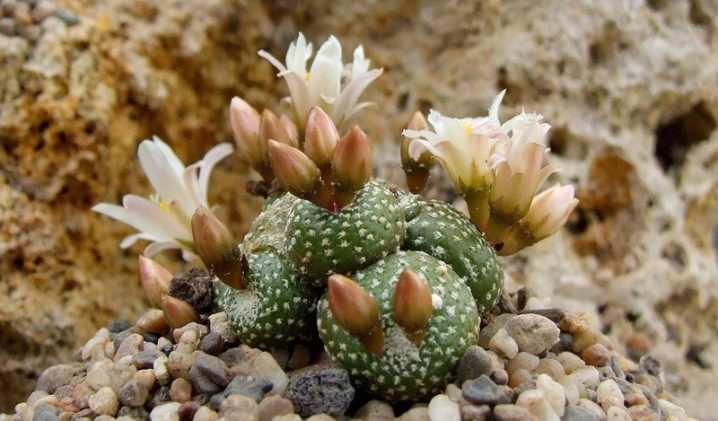
All about growing cacti at home in the video below.























































The comment was sent successfully.